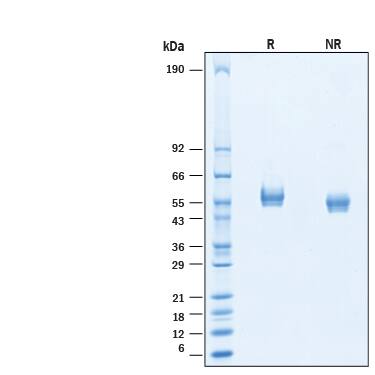Recombinant Cynomolgus Monkey CD4 His-tag Protein, CF
R&D Systems, part of Bio-Techne | Catalog # 10952-CD

Key Product Details
Product Specifications
Source
Chinese Hamster Ovary cell line, CHO-derived cynomolgus monkey CD4 protein
Lys26-Pro396, with a C-terminal 6-His tag
Lys26-Pro396, with a C-terminal 6-His tag
Purity
>95%, by SDS-PAGE visualized with Silver Staining and quantitative densitometry by Coomassie® Blue Staining.
Endotoxin Level
<0.10 EU per 1 μg of the protein by the LAL method.
N-terminal Sequence Analysis
Lys26
Predicted Molecular Mass
42 kDa
SDS-PAGE
51-60 kDa, under reducing conditions.
Activity
Measured by its binding ability in a functional ELISA.
When serially diluted Recombinant Cynomolgus Monkey CD4 His-tag is coated on the plate, it binds Human CD4 Biotinylated Antibody (Catalog # BAF379) with an ED50 of 25.0-250 ng/mL.
When serially diluted Recombinant Cynomolgus Monkey CD4 His-tag is coated on the plate, it binds Human CD4 Biotinylated Antibody (Catalog # BAF379) with an ED50 of 25.0-250 ng/mL.
Scientific Data Images for Recombinant Cynomolgus Monkey CD4 His-tag Protein, CF
Recombinant Cynomolgus Monkey CD4 His-tag Protein SDS-PAGE.
2 μg/lane of Recombinant Cynomolgus Monkey CD4 His-tag Protein (Catalog # 10952-CD) was resolved with SDS-PAGE under reducing (R) and non-reducing (NR) conditions and visualized by Coomassie® Blue staining, showing bands at 51-60 kDa.Formulation, Preparation and Storage
10952-CD
| Formulation | Lyophilized from a 0.2 μm filtered solution in PBS. |
| Reconstitution | Reconstitute at 1.00 mg/mL in PBS. |
| Shipping | The product is shipped at ambient temperature. Upon receipt, store it immediately at the temperature recommended below. |
| Stability & Storage | Use a manual defrost freezer and avoid repeated freeze-thaw cycles.
|
Background: CD4
References
- Vignali, D.A.A. (2010) J. Immunol. 184:5933.
- Maddon, P.J. et al. (1985) Cell 42:93.
- Alarcon, B. and H.M. van Santen (2010) Sci. Signal. 3:pe11.
- Wan, Y.Y. and R.A. Flavell (2009) Mol. Cell Biol. 1:20.
- Kitchen, S.G. et al. (2005) Proc. Natl. Acad. Sci. 102:3794.
- Crocker, P.R. et al. (1987) J. Exp. Med. 166:613.
- Biswas, P. et al. (2003) Blood 101:4452.
- Bernstein, H.B. et al. (2006) J. Immunol. 177:3669.
- Funke, I. et al. (1987) J. Exp. Med. 165:1230.
- Doyle, C. and J.L. Strominger (1987) Nature 330:256.
- Huppa, J.B. et al. (2010) Nature 463:963.
- Fragoso, R. et al. (2003) J. Immunol. 170:913.
- Cruikshank, W.W. et al. (1994) Proc. Natl. Acad. Sci. 91:5109.
- Klatzmann, D. et al. (1984) Nature 312:767.
- Dagleish, A.G. et al. (1984) Nature 312:763.
Alternate Names
CD4
Entrez Gene IDs
Gene Symbol
CD4
UniProt
Additional CD4 Products
Product Documents for Recombinant Cynomolgus Monkey CD4 His-tag Protein, CF
Product Specific Notices for Recombinant Cynomolgus Monkey CD4 His-tag Protein, CF
For research use only
